As Friends of the Smokies begins its twenty-fifth year of service, over $60 million has been generated for the benefit of the Great Smoky Mountain National Park—far and away Americas most visited of all of its “crown jewels.” Today, supporters representing every one of nations the 50 states contribute almost 4 million per year. Being a part of Friends for the last quarter century has been an absolute privilege.
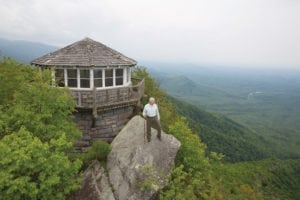
One of our most ardent supporters is Dannie Bernstein. A prolific hiker, having completed both the Appalachian Trail from Georgia to Maine and the 1,000 mile Mountain-to-Sea Trail across North Carolina, she now lives in western North Carolina and volunteers time, talent, and treasure to Friends of the Smokies. An author of note, Dannie also plans and leads the annual Classic Hikes Series for Friends. In November of last year, she was the featured guest at the organization’s quarterly board meeting in Gatlinburg. When the discussion turned to the upcoming 25th Anniversary of Friends, she turned to me, smiled, and asked, “Is it truth or legend? What’s the real story about how the Friends of the Smokies got its start?” I gave my usual short answer. “Years ago, a longtime friend and I hiked to the historic Mt. Cammerer Fire Tower in the Smokies, only to discover how poorly the structure had been maintained. My friend, an architect, recognized the uniqueness of the design and complained to Park Superintendent Randy Pope about its lack of care. Before the meeting was over, my friend volunteered to draw the reconstruction plans and then nominated yours truly to raise the necessary funds. Capitalizing on the moment, Superintendent Pope developed a far more ambitious plan, calling the organization meeting for Friends of the Smokies on September 3, 1993.” Thus, Dannie heard my “Reader’s Digest” version.
A longer version of my story, solely from my perspective, really began in the summer of 1957 when I encountered an especially enthusiastic 10 year-old boy playing badminton at a church camp in Townsend. The name “Tommy” had been threaded into one of those Robin Hood type souvenir caps so popular in those days in Gatlinburg, where he then lived. On the first day of the 5th grade class at Sevierville Elementary School, I recognized the “new boy” as the same Tommy I had seen two months earlier. His parents had moved to Pigeon Forge to start what became known as Trotter’s Restaurant, a popular family style eatery that lasted for decades. As the years passed, Tommy and I shared the same friends, played sports together, and, after we had completed our education, became a part of the Sevier County workforce. He acquired his architectural license and founded his own firm—Trotter and Associates—which is known today for its artistic commercial and residential designs, befitting of our mountain environment. In the early 1990s Tommy telephoned, “Gary,” he gasped, as if it were an emergency, “We’re over 40 years old! We have grown up in the shadows of the Smokies and should have hiked all the trails by now!”
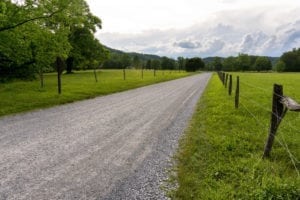
He challenged me to set aside a couple of weekend days each month for hiking, and acquired a map of the marked trails. Over the next two or three years, he carefully charted each of the hikes we made. The more popular the trails, such as the Chimneys, the various routes to LeConte, and Charlie’s Bunion, were first on our list. Tommy’s family had spent much of their free time in the Elkmont area, and he made sure I was exposed to every trail from the Sugarlands Center to Cades Cove—Jake’s Creek, Huskey Gap, and Blanket Mountain were some of his favorites. I, on the other hand, had spent much of my childhood near the Big Greenbrier entrance to the Park, east of Gatlinburg. So I was eager for Tom to experience trails like Ramsey Cascades, Maddron Bald, Porter Flats, and the Pinnacle.
During this time, my older brother, Dr. Dwight Wade, Jr. (the Eagle Scout in our family), and I hiked together on a day Tommy was out of town, using the Low Gap trail from the Cosby Campground to the fire tower on top of Mt. Cammerer. Tommy was eager to see what we had seen and so he and I made the trek a few weeks later. Octagonal in shape and with a 360 degree view, the tower featured a foundation of mountain stones, blocked from a mountainside quarry only 100 feet away. Some stones weighed over 600 p
ounds. While genuinely inspired by the structure, Tommy cringed at the dilapidated condition of what had served, in its day, as comfortable living quarters for the ranger on duty. The catwalk, the floor, the windows, and the roof were all in need of major repair. Sheer cliffs to the north and the east presented a real danger to those who ventured into and around the imposing tower.
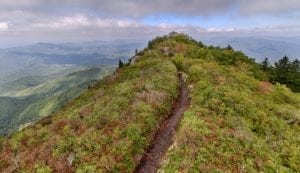
When a back-country ranger arrived, Tommy inquired whether the tower would be repaired, and learned that Superintendent Pope was interested in having something done, but that there were no funds available. Tommy handed the ranger his business card, and remarked, “If Randy Pope wants to fix this thing, tell him that I will donate the architectural drawings. Ask him to give me a call,” he said, not actually expecting that he would be contacted.
To his surprise, Superintendent Pope scheduled a meeting and patiently explained that the Congress had failed to appropriate amounts sufficient for the upkeep of the numerous historic structures. While pleased that Tommy would be willing to donate his architectural talents, the superintendent asked how he might be able to raise the $35,000 or so necessary for construction, Tommy answered, “Don’t worry, I’ll leave that up to my friend, Gary Wade.”
Now that I have provided “my” short and long renditions of the events leading to the Friends’ formation (both of which are overly self-serving), I can now reveal the real story–as told by Superintendent Pope, who retired three months after the incorporation of Friends, but still lives in Gatlinburg. From 1984 to 1993, the Smokies had lost millions of dollars in federal budget cuts. Then Maryville Times Editor Dean Stone, a park enthusiast, knew about the shortfall and planted the support organization idea with Superintendent Pope circa 1991. Members of the Pigeon Forge Rotary expressed similar thoughts after Superintendent Pope had made a presentation to the club illustrating the effect of the cost cutting on all natural parks. During this time, the superintendent monitored the progress of the Yosemite (Friends) Fund created in 1988, but was reluctant to “pull the trigger” for the Smokies for fear that Congress would reduce the annual appropriation by whatever funds might be raised privately. After determining that gifts to the Yosemite Fund did not cause its share of the federal dollars to diminish, the superintendent chose to push forward. He set a date for a meeting designed to establish a support group for the Smokies.
On September 3, 1993, Superintendent Pope and Bob Miller, then the media “Voice of the Park”, hosted an organization meeting for what became Friends of the Great Smoky Mountains National Park. Among the invitees were prominent philanthropist Lindsay Young, Western Carolina University Chancellor Barney Coulter, Steve Woody of the Cataloochee Woodys, Judy Morton (Morton’s Overlook), Kathy McNeil (who with Voit Gilmore had agreed to donate hundreds of acres in North Carolina to the Park), conservationist and real estate broker Mary Johnson, Knoxville’s own Natalie Haslam, and myself. Within a few weeks, we were soon joined by Asheville banker and outdoor photographer John Dickson, noted author and historian Wilma Dykeman Stokely, former TVA chair John Waters, UT Vice President Jack Williams, businessman David White, and Cherokee Magistrate Lee Jones (who was later elected Tribal Chief on the Eastern Board).
I remember the Rotary Club of West Knoxville to be the very first to offer help. Led by avid hiker, Bob Ely, the Rotarians, persuaded artist Terry Chandler to donate a painting of the Cammerer tower. The sale of Terry’s prints largely covered the cost of restoration (the original hangs in the Friends office). Bill Stokely, III provided a helicopter to deliver the construction materials and, by 1995, the very first project of “Friends of the Smokies” had become a reality. The tower had been restored to its former glory.
Meanwhile, the new board solicited and received 151 $1,000 gifts from what we have called our charter members, a list which included such notables as Lamar Alexander, Ned McWherter, and Phil Bredesen. Karen Wade (no relation) had succeeded Randy Pope as superintendent. Methodist Minister Charles Maynard of Seymour, a hiker, writer, and photographer, agreed to volunteer his spare time “between Sundays” as Executive Director until we could afford a full time salary. By September of 1994, Charles became Friends’ first executive director and his assistant at church, Nancy Best, became the second employee. After laying the foundation for future success, Charles returned to the ministry, and the Board recruited former WBIR TV/Owner/General Manager Jim Hart (“Straight from the Heart” and “Heartland Series”) to take over with the title of President. Over the last fifteen years, Jim has recruited a remarkably talented staff, all dedicated to providing support essential to the future of the Smokies, and a host of committed volunteers (Ellie Burbank, for example, has given Friends over 17 years of service to the Friends office operations). Jim’s leadership has been absolutely critical to the progression of the organization.
So, I give Superintendent Randy Pope the credit for our beginning. In the 1920s, the people in and around Knoxville and Asheville initiated the movement to create a national park in the Smokies. Led by Tennesseans and North Carolinians, with a grant boost from John D. Rockefeller, Jr, the Smokies “opened for business” June 15, 1934. Today, the Friends and its partners, the Great Smoky Mountain Association, the Great Smoky Mountains Institute at Tremont, and Discover Live in America, are simply following in the steps of those early visionaries. Trail maintenance, scientific research, the sustenance of historic structures, wildlife protection, habitat restoration, and the introduction of young people to nature’s wonders are chief among the accomplishments of Friends and our sister organizations.

The Mt. Cammerer Fire Tower, situated along the Tennessee/North Carolina boundary, has come to symbolize the commitment of “we the people” to cherish these mountains for all posterity.
Jim Hart
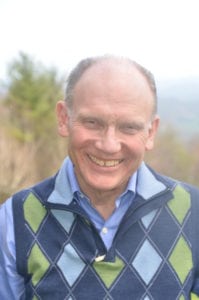
Under the leadership of Jim Hart, Friends of the Smokies assists in raising money to help the park with several items federal funding can’t cover. Hart, who grew up in Knoxville and has enjoyed the park his whole life, wanted to retire from his 35-year-long broadcasting career—but he wanted to have an active retirement. He jumped straight into Friends of the Smokies and has been involved with it for more than a decade. Hart says Friends of the Smokies has more than 2,000 volunteers—but there’s always room for more. Volunteers assist with everything from visitor information to trail work. If you don’t have time to volunteer, Hart encourages you to participate in other ways, whether it’s purchasing a Friends of the Smokies license plate or attending the annual Evergreen Ball. For more information on how to get involved call their offices or visit www.friendsofthesmokies.org.
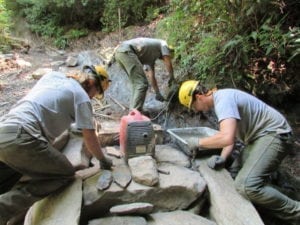
Trails Forever
Trails forever was originally funded with a matching grant from Aslan Foundation in 2008. Currently a $5 million endowment, they fund a full-time trail crew to maintain trails in the park. This includes updating trails for better accessibility and reconstruction. Their current project is Phase 2 of the Rainbow Falls Trail which involves stabilizing sections of the trail that have eroded and to prevent further damage to the landscape. To volunteer with the Trails Forever crew and work alongside NPS staff, visit friendsofthesmokies.org.
Cassius Cash
Publisher Nathan Sparks had the opportunity to speak with GSMNP Superintendent Cassius Cash on Friends of the Smokies and their mission in the national park.
Nathan Sparks: What does Friends of the Smokies mean to you?
Cassius Cash: Friends of the Smokies is the life line for us to get a lot of the projects done that we brag about such as restoring cultural sites or hiring temporary rangers to be in class rooms. They help us carry out the mission of the National Park Service.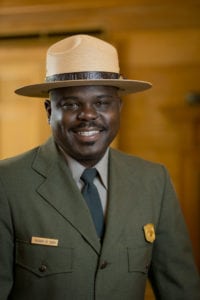
N: Our park doesn’t require an entrance fee which allows a lot more people access to the park, doesn’t it?
C: That is correct. That is a proud point of the Great Smoky Mountains National Park. Even though we have more visitors coming in and our staffing is going down a tad, we are able to leverage our ability to provide a quality visitor experience through the funding source of the Friends. Again, a valuable piece to us is being able to carry out the mission of the Park Service and also provide an education to our youth for the next generation, and also to provide a quality experience to those 11.3 million visitors that come to the park on an annual basis.
N: The Friends right now are taking on a project to help revitalize/create a new radio broadcast system for all of the first responders and rangers in the park. Is that a vital project?
C: Yes, that’s the critical infrastructure that people don’t see. Radio systems are invaluable, whether it’s from daily operations to rescuing someone in the back country that may be hurt. This upgraded system will allow us to talk to emergency services outside of the park boundary, which we could not do before.
N: What your favorite project that you’ve worked on with Friends of the Smokies?
C: My favorite one would have to be restoring our cultural sites, like the cabins. We have more log cabins than any other national park in the country. To be able to restore those cabins allows us to keep the stories alive of the folks that were living in this part of the country before it became a park. I think that’s as important as it is to preserve our natural resources.
N: The firetowers in the back country were the original Friends of the Smokies project (specifically Mt. Cammerer), is that going to be restored again?
C: We were originally looking for that to be a signature project for the anniversary of the Friends this year, but we had it in queue so we did some restoration work on it last year. It will remain intact and in good shape for people to be able to experience what a firetower looked like in the Great Smokies.
N: What would you say to the visitors of the park is the #1 thing that you wish people would do?
C: An obvious one is to respect the wildlife. We understand that people come here to experience elk or black bears, which is the signature animal for the Smokies, but it’s important to remember that these animals are wild and could hurt people. People can have a quality experience while seeing wildlife, but also not endanger themselves. That would be our message to our visitors.
N: Is there anything you would like to add?
C: In regards to the Friends of the Smokies, they are an organization made incredible by people that have given their time, talent, and resources to allow us 25 years of support in. That’s a legacy that we want to be able to carry out. If you’re not part of Friends of the Smokies, it’s a great organization to look into because we are preserving something that is bigger than ourselves. As part of Friends of the Smokies, I aim to carry out their mission long after I’m gone—and that’s a powerful mission to be a part of.
Friends of the Smokies 25th Anniversary Print

Robert Tino’s landscapes have captured the beauty of the Smoky Mountains for decades. When we approached him earlier this year about the idea of doing an original work in honor of the 25th Anniversary of the Friends he was delighted to help as always.
This painting depicts a scene from a section of the Alum Cave Bluffs Trail, one of the more popular hikes in the park. Hikers use this trail as popular route to Mt. LeConte. We highly recommend this trail during the fall colors.
We are happy to inform our readers that beginning on October 1st, 2018 Robert will be offering Giclée prints on paper or canvas. A portion of all proceeds will be donated to benefit the Friends of the Smokies. Contact Robert Tino Galleries for more information. www.robertatinogallery.com
How You Can Help
Friends of the Smokies produces an annual park support list that details their current projects and how much money is needed to complete them. Donors have the option of choosing a specific project they would like to fund. The projects are divided into five categories: 1) Wildlife, Wonders, and Wilderness (Resource Management and Science), 2) Environment Education, 3) Parkwide Volunteers-In-Park Program, 4) Protecting Historic Places (Facilities Management), and 5) Improving Visitor Experience (Resource and Visitor Protection).
The 2018 Park Support List totals $1,276,945 of donations needed to complete all projects. Here’s a few that you can support:
Wildlife, Wonders, and Wilderness
- Support Appalachian Bear Rescue
- Bear Management Program
- Elk Management and Monitoring
Environmental Education
- Smoky Mountain University (Year 1)
- Urban Youth Program at Purchase Knob
- Support Parks as Classrooms programs
Parkwide Volunteers-In-Park Program
- Artist in Residence
Protecting Historic Places
- Cable Mill Water Wheel Replacement
- Clingman’s Dome Observation
Tower Rehabilitation
- Trails Forever Rehabilitation of
Rainbow Falls Trail (Phase 2) Improving Visitor Experience
- Cades Cove Bike Patrol
- Preventive Search and Rescue
Ridgerunner Program
- Remote Surveillance Cameras
